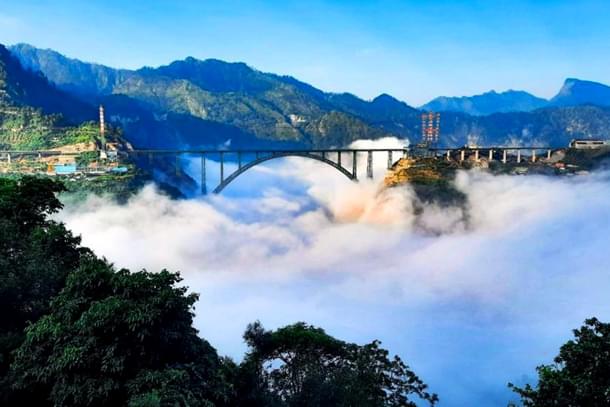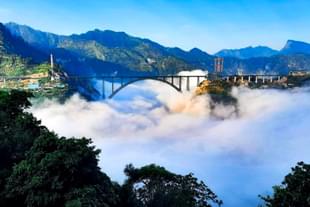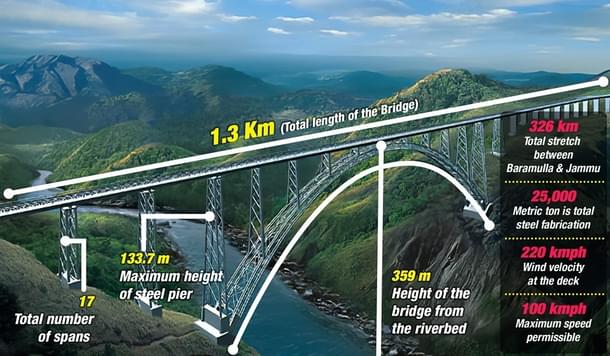Infrastructure
World's Highest Rail Bridge Set To Open In India Soon — All You Need To Know
V Bhagya Subhashini
Jun 17, 2024, 04:04 PM | Updated 04:41 PM IST
Save & read from anywhere!
Bookmark stories for easy access on any device or the Swarajya app.


The eagerly anticipated train service from Ramban to Reasi in Jammu and Kashmir will commence soon, according to the Northern Railway. The train will cross the world's highest railway bridge over the Chenab River.
Railway Minister Ashwini Vaishnaw said Sunday (16 June) that the inaugural trial run of the Sangaldan-Reasi train was conducted successfully, "including crossing the Chenab Bridge."
The 1,315-metre (m) bridge is a critical component of the Rs 35,000 crore Udhampur-Srinagar-Baramulla Rail Link (USBRL) project, which aims to improve connectivity in Jammu and Kashmir.
"All construction works for the USBRL are nearly finished, with tunnel No.1 remaining partially incomplete," Minister Vaishnaw said.
Currently, trains operate along the extensive railway line from Kanyakumari to Katra, while services run from Baramulla to Sangaldan in the Kashmir Valley.
Railway officials recently conducted a thorough inspection of the newly constructed railway line and stations between Sangaldan in Ramban district and Reasi.
The Deputy Chief Engineer of Konkan Railways, Sujay Kumar, acknowledged the project's challenges and expressed optimism about its completion.
Reasi Deputy Commissioner Vishesh Mahajan has hailed the bridge as an "engineering marvel of the modern world."
"The day the train reaches Reasi will be a game-changer for the district. Our engineers have created a marvel, and it is the eighth wonder of the world," Mahajan said.
A Feat Of Engineering Excellence
The Rs 14,000 crore-worth Chenab Bridge stands 359 m (around 1,178 feet) over the Chenab River, making it 35 m taller than the Eiffel Tower in Paris, France.
The bridge is designed to withstand winds of up to 260 kilometres (km) per hour and is expected to have a shelf life of around 120 years. It has a 20.15 km-long approach road and is earthquake-resistant.

Notably, Indian Railways has implemented a comprehensive safety measure to minimise the potential impact of a bomb blast on the bridge. A 780-m-long blast protection platform, a first in India's rail sector, will feature on the bridge's surface to absorb explosion impact during train operations.
The protection platform is positioned on both sides of the track on the bridge, comprising 165 steel decks, some measuring 17 m in length and the rest 13.5 m.
The bridge construction process involved excavating about 12 lakh cubic metres of earth. Globally renowned tunnelling experts are contributing to the tunnelling works underway in the section.
The sophisticated Tekla software has been deployed for structural detailing using structural steel suitable for temperatures between -10 degrees Celsius and 40 degrees Celsius.
As part of the smart asset management system, 120 sensors are installed as part of the structural health monitoring system for the Chenab arch bridge. These sensors operate round the clock and provide essential real-time data on various factors like wind velocity, temperature, humidity, and vibrations.
The construction of the bridge entailed the fabrication of 28,660 metric tonnes of steel, 10 lakh cubic metres of earthwork, 66,000 cubic metres of concrete, and the construction of 26 km of motorable roads.
The project required the collective efforts of more than 1,300 workers and 300 engineers.
A Testament To Perseverance
Approved in 2003 and contracted in 2008, the project faced numerous challenges, from the complex geographical terrain to concerns about safety and stability.
Building the massive arch alone took three years, requiring two mammoth cable cranes on either side of the valley.
The bridge was also subjected to rigorous tests, including high-velocity winds, extreme temperatures, earthquake resilience, and hydrological impacts.
Significance Of The Bridge
For the people of Jammu and Kashmir, the bridge represents the culmination of a two-decade wait since its first approval in 2003.
Once the USBRL project becomes fully operational, a Vande Bharat Metro train will run between Jammu and Srinagar, further enhancing connectivity.
The inauguration of this service is set to significantly improve economic and social integration for the people of Jammu and Kashmir.
It can play an important role in rapid industrialisation, the movement of raw materials and finished products from the Union territory, and encouraging trade and tourism in the region, apart from providing opportunities for employment.
The railway line will also prove useful for the armed forces deployed in this strategic region.
V Bhagya Subhashini is a staff writer at Swarajya. She tracks infrastructure developments.





